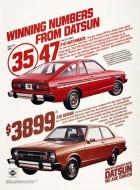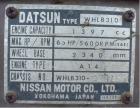A stock Datsun 1200, in good condition and state of tune, should get around 38 miles/US gallon in highway travel (16 liters/kilometer). Economy will be less in town, stop-and-go traffic. Note that most 1200 Speedometers are off -- almost always reading more miles that you really traveled -- so base your calculations on a corrected speedometer factor.
Contents |
Overview
The Datsun 1200 got a fuel economy of about 24 city and 38 highway. I used to keep records, and I got about 32 rural/38 highway (after adjustment for speedometer error, see 'top speed' above).
You don't believe it? Here are some actual test results:
MOTORMAN magazine: Range between 24 and 32 miles per gallon. Average on test, 28.9mpg.
Consumer Reports 1971 September Road Test: RANGE OF AS MILEAGE TO BE EXPECTED IN NORMAL USE (mpg) ... 23-41 TANK MILEAGE OBSERVED ON 300-MILE TEST TRIP (mpg) ... 35
28 mpg overall: Road Test - Road & Track (November, 1970)
32.5 on the 1973 Datsun 1200: Motor Trend
35.3 mpg:
We drove the little Datsun from Daytona to St. Augustine and back -- a total of 106 mi. -- on some second-grade roads. At an average speed of 48-plus mpd, the rig from the Land of the Rising Sun got 35.3 mpg, making the round trip on exactly 3 gallons of gas. Mechanix Illustrated
Other Sunny Models
1977 Introducing the B-210 'Plus'

50 miles per gallon
* 63-series 'dogleg' 5-speed and low-RPM A14 engine
Nifty Fifty - 1978 USA B210 'Plus' with 5-speed

50 MPG (56 Imperial mpg)
* A14 with 3.700 diff ratio
1979 B310: Winning Numbers From Datsun

47 MPG
* A14 with 3.454 diff ratio
* 
* 65 HP A14 (instead of regular 80 HP A14)
Considerations
These factors will greatly decrease your fuel economy:
- Weight: Carrying unnecessary weight in the car, e.g. Tools, spare parts, heavier "upgraded" diffs and transmissions. Also having passengers will lower economy. This applies to acceleration (town traffic) and not at all to flat-road highway driving)
- Dragging brakes. Jack each wheel and ensure they turn freely by hand. It is not uncommon to have stuck brakes, often due to:
- leaking brake fluid
- leaking axle grease
- seized/unlubricated caliper
- incorrectly adjusted drum brakes
- incorrectly adjusted emergency (parking) brake
- Choke not working correctly. With engine fully warm, remove air cleaner and ensure the choke butterfly valve is fully open. Even a little bit off from straight up/down will cause too much fuel to be used
Engine Tuning Factors
- Choke freely operating
- Choke pulloff working correctly
- Choke warming up fully
- Distributor Vacuum advance working freely (cars with VA disconnected will use more fuel)
- Distributor centrifigal (mechanical) advance freely working
- Vacuum leaks
- hot Air cleaner intake correctly functioning (warm air is best for fuel economy)
- Clean oil
- Clean air filter
- Fan belt properly adjusted
- Emission controls connected and operating
- PCV valve not stuck/dirty
Chassis Factors
- Brakes not dragging
- Correct wheel alignment (most especially toe-in)
- Correct tire pressure. Higher pressue is better for fuel economy, up to the limit printed on the tire. However, for proper tire wear, use Datsun's recommendation. Just don't go below it.
Driver Habits
- Do not let car warm up for several minutes before driving -- that is 0 miles/gallon when the car is not moving. Start the engine, and drive off moderately after 30 seconds. If your car won't idle this soon, inspect/repair/re-adjust the choke mechanism.
- Get into your highest gear as soon as possible, but go as slow as reasonable. This means 4th gear @ 35 mph for a stock 1200. Lower gears use more fuel. Higher speeds use more fuel.
- Plan trips. For example, combine two errands into one, instead of making separate trips. Wait for another day to combine errands.
- Avoid short trips on cold days, where the choke-on condition uses twice the fuel
- Avoid jack-rabbit starts
- Avoid last-minute braking
- Anticipate stops, approach gradually
- Let the car coast faster down hills and go slower up hills if speed laws allow. Otherwise maintain a constant speed.
- Install a vacuum gauge in the cockpit and try to keep vacuum as high as possible (by slow, moderate acceleration)
- Do not ride the clutch. Your foot should be off the clutch as soon as the car is moving.
- Do not ride the brake pedal. Your foot should be off unless stopping/slowing the car
- Keep your foot steady on the accelerator pedal
- Use regular-grade (inexpensive) gasoline. Your 1200 is designed to run correctly on today's low-octane fuel.

![[Datsun 1200 encyclopedia]](/wiki/upload/wiki.png)
